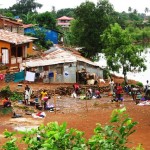Overcoming Assumptions to Find Common Ground
By Woodrow Covington
As I was walking in the hills above Freetown on my third day in Sierra Leone, my guide, Mohammed, pointed to a large structure on the opposite hill. It was easily the largest building I had yet seen in the country, and was ringed by a tall metal fence that enclosed a compound of several acres. It is difficult to overstate how large and intimidating the building was – vertical, gray stone walls inlaid with massive black, tinted windows – and how out of place it looked compared to the rickety wood and corrugated metal structures on the rest of the hillside.
“Embassy of America,” Mohammed told me.
As we approached it, the small citadel became even more imposing. No people were visible through the tint in the huge windows, only a manhole-esque metal seal of the United States set into the front wall and signs warning those who approached that taking pictures or videos was strictly forbidden. The only part of the embassy not in grayscale was the American flag flapping in the breeze above it. The whole enclosure looked like it was built to withstand a war, and it probably was.
In contrast to the grey regularity of the embassy, the other buildings on the surrounding hillsides were composed mainly of gapped wood siding, built into the flattest parts of hillside. Most that I passed had dirt floors, with the occasional small counter built in for selling bread, candy, and other goods. One place, an open-air bar, was showing a soccer game on a tiny television, with a group of men enthusiastically crowded around it. Trash piles spilled into the dirt road (paved up to the embassy, but not beyond), with small rivulets carrying the morning’s rains downhill and deepening the already formidable ruts in the road.
…
The following afternoon I was again walking in the hills, and I met two women on the road near the village where I am staying. As I approached, they greeted me and asked how I was doing. I replied that I was fine, and asked the same about them. One said, as she looked me up and down with a skeptical eye,
“We are fine… But not as fine as you are.”
…
Search for Common Ground is in the business of building healthy relationships between people and groups; after all, what is violent conflict but the complete breakdown of a relationship? To transform conflict, as is SFCG’s stated goal, those relationships must be transformed as well. However, an essential element of dealing with those relationships is managing and moving beyond the perceptions and assumptions that each side has of one another – and of the outside practitioner working with them.

In a rural village outside the town of Bo, children ran up as soon as Woodrow’s car stopped, shouting ‘bomui, bomui’ which means ‘white man’.
These two incidents served to remind me of the power of perceptions and assumptions. Though Sierra Leoneans generally seem to have a positive opinion of the U.S. – the bar where the men were watching soccer had ‘Obama’s Spot’ painted on the side – there is no mistaking that I look, speak, and act differently, and am treated differently by default. Despite the fact that I am an unpaid intern, and far from wealthy, simply being a white-skinned person in Sierra Leone speaks volumes to people here before I ever manage to say a word.
A distinct challenge of working in the peacebuilding field is managing assumptions like these and finding ways of moving beyond them. This applies to assumptions about third party mediators as much as it applies to local actors. For example, negative assumptions of different sides in an ethnic conflict can be an incredibly difficult obstacle to reconciling differences and transforming relationships; likewise, it can be difficult for people perceived as ‘outsiders’ to gain the trust of the local people with whom they are working.
In many post-conflict areas, the stereotypes each side has about “the other” seem to be remarkably similar, and remarkably negative. Each side believes the other was the instigator, that Group X, whether Hutu, Serbian, Palestinian, or any other group involved in a conflict, is inherently untrustworthy, aggressive, unclean, or any number of other negative stereotypes. Furthermore, these judgments are made almost instantaneously and unconsciously. People and groups tend to define themselves in opposition to others, cementing their personal or group identity by vilifying an outgroup. It is much easier to label someone as a member of Group X and discount them than it is to realize that their differing opinion may have some legitimacy or that they might not fall within preconceived notions of how members of Group X behave.
Various peacebuilding and mediation tools exist to subvert the power of these knee-jerk assumptions, and almost all of them necessitate the recognition of a shared humanity, complete with differing viewpoints and opinions. This is at the core of many relationship-building efforts, and is most often the source of the ‘common ground’ after which SFCG is named. Setting aside preconceived notions and recognizing common interests and experiences is at the heart of the peacebuilding field, and can be incredibly difficult to facilitate. To find these areas of commonality, however, those in the peacebuilding field must recognize the assumptions that are made about them as well, and approach their work accordingly.
Though Sierra Leoneans may have an impression of the size and wealth of the U.S. and other western countries, the grey panopticon of an embassy here serves as a forceful physical embodiment of those ideas. Walking on the street, I have to bear in mind that my skin color and appearance are somewhat linked to that representation of my country. But, by being aware of the perception, hopefully I can enable myself and others to move beyond it, both in my daily life here and in my work. Collaborating to overcome shared obstacles is, after all, a helpful tool for finding common ground.
*Author’s Note: As detailed above, taking pictures of the U.S. Embassy in Freetown is not permitted. However, it presents such a striking image that I couldn’t resist. As I was quickly taking a couple shots of the compound, a truckload of armed, camouflaged Sierra Leoneans literally screeched to a stop next to me; before I knew what was happening, three of them jumped out and forced me into the vehicle. They drove me to a secure building, deleted all the pictures I had taken that day, plus several others, and questioned me repeatedly about why I was photographing the embassy. Definitely the most exciting photography experience I’ve had! Luckily the only casualties were a few photographs.
Woodrow Covington is a recent graduate of Georgetown University’s Conflict Resolution M.A. program and is currently conducting research for Search for Common Ground Sierra Leone on natural resources and conflict in the country as well as evaluating an ongoing national elections project. He has previously held positions at the EPA’s Conflict Prevention and Resolution Center as well as at the United Nations Development Program, and is originally from northern California. He can be contacted at wcovington (at) sfcg.org.












